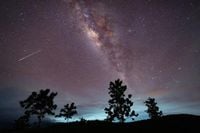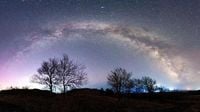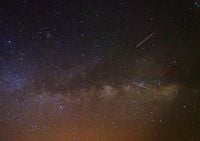The Eta Aquariid meteor shower put on a stunning celestial show over Marin County, California, in the early hours of May 6, 2025. Breathtaking timelapse footage captured meteors streaking across the sky above Point Reyes National Seashore, with the Milky Way glowing in the background. This annual spectacle occurs as Earth passes through debris from Halley’s Comet, the most famous comet in recorded history.
On the same night, 50 astronomy enthusiasts gathered under the quiet desert skies of Al Kharrara in Qatar to witness the peak of the Eta Aquariid meteor shower. Though the meteor activity in Qatar was modest compared to other parts of the world, observers reported an average of five meteors visible per hour. Bursts of fireballs and streaks of light lit up the early morning darkness, creating an awe-inspiring experience.
Renowned astrophotographer Ajith Everester, founder of the Everester Observatory, noted, "The Eta Aquariids are known for their swift, bright meteors often leaving long glowing trails and occasionally bursting as fireballs. In Qatar, observers spotted an average of five meteors per hour during the peak window from late May 5 into the early hours of May 6." The event was organized by the Qatar Astronomy & Space Club, part of the Everester Observatory, which regularly hosts public viewing events to promote astronomy in the region.
According to NASA, the Eta Aquariids, which are active from April 20 to May 21, originate from particles shed by Halley's Comet during its 76-year journey around the Sun. The radiant point, where the meteors seem to emerge, lies in the constellation Aquarius, near the star Eta Aquarii, which gives the shower its name. The Eta Aquariids are one of the year’s most anticipated sky events, especially in the Southern Hemisphere, where activity can be much more intense.
In the Northern Hemisphere, the viewing conditions were not as favorable. NASA indicated that under optimal conditions, about 50 Eta Aquariid meteors could be seen per hour during the shower's peak, but light from the waxing moon washed out the fainter meteors this year. Bill Cooke, who leads NASA's Meteoroid Environments Office, stated that viewers could expect only 10-15 meteors per hour just before dawn on May 6.
For those hoping to catch the meteors at their peak, NASA advised going outside around 2 a.m. local time on Tuesday, May 6, when the moon was set to disappear around 3 a.m., leaving the skies dark until dawn. The Eta Aquariids travel about 40 miles per second, and many of the meteors are considered "Earthgrazers"—long meteors that appear to skim the surface of the Earth at the horizon. This unique characteristic makes the Eta Aquariids particularly fascinating to observe.
As the excitement around the meteor shower grew, many were reminded of Halley’s Comet, which last passed Earth in 1986 and won’t return until 2061. Everester remarked, "These meteors may be few in number here, but each one is a piece of cosmic history. Every streak is a reminder of Halley’s Comet, which won’t return until 2061, yet continues to grace our skies through this annual meteor shower." This connection to Halley’s Comet adds a layer of historical significance to the Eta Aquariids.
For viewers in Pennsylvania, the Eta Aquariids were also visible through the end of May 2025, although the peak viewing times had already passed. The duration of the meteor shower was set to end on May 27, 2025. NASA noted that the viewing conditions were better in the Southern Hemisphere, where the constellation of Aquarius is higher in the sky compared to the Northern Hemisphere.
As the Eta Aquariids captivated audiences around the globe, it served as a reminder of the wonders of the universe and the beauty of celestial events. The combination of scientific knowledge and community engagement through events like those organized by the Qatar Astronomy & Space Club highlights the importance of astronomy in fostering a sense of wonder and curiosity about the cosmos.
In conclusion, the Eta Aquariid meteor shower provided a spectacular display for skywatchers in both California and Qatar on May 6, 2025. Whether it was the breathtaking footage captured in Marin County or the communal experience shared by astronomy enthusiasts in Qatar, this celestial event brought people together to appreciate the beauty and mystery of the universe. As Halley’s Comet continues its long journey through space, the Eta Aquariids remind us of the connections we share with the cosmos and the ongoing legacy of one of history’s most famous comets.






